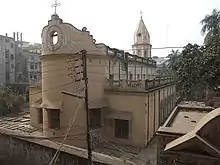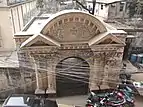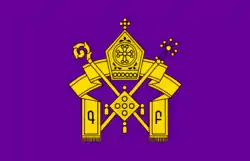Armenian Church, Dhaka
The Armenian Church, also known as Armenian Apostolic Church of the Holy Resurrection (Armenian: Դաքքայի Սուրբ Յարութիւն Եկեղեցի),[1] is a historically significant architectural monument situated in the Armanitola area of old Dhaka, Bangladesh. The church bears testimony to the existence of a significant Armenian community in the region in the 17th and 18th centuries.
| Holy Resurrection Church Սուրբ Յարութիւն Եկեղեցի | |
|---|---|
 Holy Resurrection Church, Dhaka | |
| Religion | |
| Affiliation | Armenian Apostolic Church |
| Rite | Armenian |
| Location | |
| Location | Armanitola, Dhaka |
 Shown within Bangladesh | |
| Geographic coordinates | 23.71249286°N 90.40208727°E |
| Architecture | |
| Style | Armenian |
| Completed | 1781 |
History
Following the domination of their homeland by Persian powers of the time, Armenians were sent by their new rulers to the Bengal region for both political and economic reasons. Although the Armenian presence in South Asia is now insignificant, their presence in Dhaka dates back to the 17th century.[2] Armenians came to Dhaka for business. In Dhaka, Armenian merchants traded in jute and leather, and profitability in these businesses convinced some to move permanently to Bangladesh.[3] The area where they lived became known as Armanitola.[4]
In 1781 the now famous Armenian Church was built on Armenian Street in Armanitola, then a thriving business district. The site was an Armenian graveyard before the church was built, and the tombstones that have survived serve as a chronicle of Armenian life in the area.[3] Agaminus Catachik, an Armenian, gave away the land to build the church. Michel Cerkess, Okotavata Setoor Sevorg, Aga Amnius, and Merkers Poges helped build the church.
In the fifty years following the church's construction, a clock tower was erected on its western side. Allegedly, the clock could be heard four miles away, and people synchronised their watches with the sound of the tower's bell. The clock stopped in 1880, and an earthquake destroyed the tower in 1897.[2] The Armenians played a prominent part in the jute trade in Dhaka and are reputed to be the pioneers of that trade in the second half of the 19th century. Today, the last Armenian that takes cares of the church is Mikel Housep Martirossian (Michael Joseph Martin).[5][6] He was also one of the Armenian who was in the jute trade.
Architecture
.jpg.webp)
The church is 750 feet (230 m) in length. It is two storied. It has 4 doors, 27 windows, all of them arched. The building plan has a main section where all the prayer activities take place and two rectangular wings on either side. The main floor is divided into three parts: a pulpit enclosed by railings, a middle section with two folding doors, and an area separated by a wooden fence for seating. Entrance into the church occurs through these two rectangular wings, which are also veranda spaces. There is a spiral staircase into the second floor of the church. For the rectangle end on the main section there are three doors on the ground door and first floor, where it turned into a balcony with railing. The rectangular wings of the church turned into terrace spaces on the first floor. Beside of this there was a watch house built by Johans Paru Piyete Sarkis. The watch house was destroyed by an earthquake in 1897. There is a square tower on the church with a "shonkhonil" (special type of minar used in India to show respect) minar on the top of it. The aisle of the church is 14 feet wide. There are some beautiful paintings in the church, by the artist Charles Port. There is a room behind the pulpit used for baptism, with a 3 foot deep marble baptismal font.
Modern use
Mother Teresa stayed in the church compound during a 1996 visit to Dhaka.[7]
In the old graveyard, amongst the 350 people buried there, a statue stands at the grave of Catachik Avatik Thomas, portraying his wife. The statue was bought from Kolkata and the grave is inscribed with the words "Best of Husband."[1]
It was a subject of BBC and AFP documentaries before it was declared as a religious and historical heritage by the government of Bangladesh and put under supervision of the Department of Archaeology, Ministry of Cultural Affairs of Bangladesh that has taken measures to restore and safeguard the cultural heritage. Government of Armenia has shown interest to cooperate in the effort of the Bangladesh government. Now the site is open during daytime for the visitors.[8]
Gallery
 Entrance archway
Entrance archway Overall view
Overall view.jpg.webp) Graves in the graveyard
Graves in the graveyard.jpg.webp) Graveyard and side of church
Graveyard and side of church Entrance to the church compound, 1965
Entrance to the church compound, 1965 View of the church from the graveyard, 1965
View of the church from the graveyard, 1965 West end of the church, 1965
West end of the church, 1965 Statue on grave of Catachik Thomas, 1965
Statue on grave of Catachik Thomas, 1965
Notes
- Kabir, Tasneem Tayeb (23 December 2011). "The Armenian Church: Legacy of a Bygone Era". The Independent. Dhaka. Archived from the original on 6 June 2013. Retrieved 27 March 2012.
- Ali, Ansar; Chaudhury, Sushil; Islam, Sirajul (2012). "Armenians, The". In Islam, Sirajul; Jamal, Ahmed A. (eds.). Banglapedia: National Encyclopedia of Bangladesh (Second ed.). Asiatic Society of Bangladesh.
- Lawson, Alastair (10 January 2003). "The mission of Dhaka's last Armenian". BBC. Retrieved 3 May 2012.
- http://www.lonelyplanet.com/bangladesh/dhaka/sights/religious/armenian-church-holy-resurrection
- http://news.bbc.co.uk/1/hi/world/south_asia/2645617.stm
- http://news.bbc.co.uk/2/hi/south_asia/2645617.stm
- Ahmed, Iftekhar (2012). "Case Studies of Informal Heritage Mangemnt in Old Dhaka". A Study of Architectural Heritage Management by the Informal Community Bodies in Traditional Neighborhoods of Old Dhaka (PDF) (PhD). National University of Singapore. p. 391. Retrieved 6 June 2015.
During her visit to Dhaka in 1996, Mother Teresa also stayed in the Church compound
- "Govt to preserve historic religious places: Minister". The Independent. Dhaka. Retrieved 7 February 2016.
References
- Muntasir Mamun: When Colonel Davidson was in Dhaka; Dhaka, 1991.
- Muntasir Mamun: Dhaka Smriti Bsmritir Nogory; Dhaka, 1993.
- Kabir, Ihtisham (16 March 2007). "Exploring Old Dhaka by Bicycle". Star Weekend Magazine. The Daily Star.
External links
| Wikimedia Commons has media related to Armenian Church of the Holy Resurrection in Dhaka. |
- A photo blog on Armenian Church in Kothay

